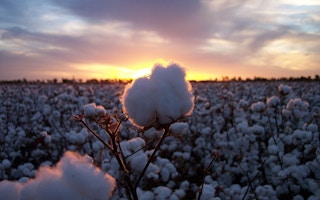Cotton is the world’s most commonly used natural fibre, and is part of the fabric of the world’s second most polluting industry - fashion. A new cross-industry initiative launched last week aims to make sustainable cotton a clothing industry staple.
To continue reading, subscribe to Eco‑Business.
There's something for everyone. We offer a range of subscription plans.
- Access our stories and receive our Insights Weekly newsletter with the free EB Member plan.
- Unlock unlimited access to our content and archive with EB Circle.
- Publish your content with EB Premium.
The coalition, called Cotton 2040, brings together existing sustainable cotton initiatives, industry stakeholders and clothing brands to encourage the use of sustainably sourced cotton in the apparel sector. This crop-specific group is led by the international sustainability non-profit Forum for the Future that offers consulting services, with support from the philanthropic arm of Dutch apparel maker C&A, the C&A Foundation.
The coalition is aiming to push production of sustainable cotton from 13 per cent to more than 30 per cent of total cotton production from 2020. Thirty per cent is typically considered to be the tipping point at which solutions to challenges, such as sustainable cotton in this case, begin to rapidly scale and enter the mainstream.
A key motivation for the coalition is that brands and retailers are often confused by the broad range of sustainable cotton sourcing options on the market, according to Forum for the Future’s senior sustainability advisor, Alexa Rees-Jones.
The group functions as a “one-stop guide” for companies to learn about the various standards of sustainable cotton, Stephanie Klotz, senior communications manager of C&A Foundation, told Eco-Business.
Furthermore, sustainable cotton represents less than 20 per cent of the more than 20 million tonnes of cotton produced annually. By working together, the goal is to increase global share of sustainable cotton, Rees-Jones said.
Members of Cotton 2040 include industry sustainability organisations Better Cotton Initiative and Cotton Made in Africa, organic standards firm Fairtrade Foundation, industry initiatives IDH and Cotton Australia, the London College of Fashion, and retail brands M&S and Target.
Cotton is one of the world’s oldest sources of textiles, but it is considered one of the world’s “dirtiest” crops for its environmental impact. Accounting for a mere 2.3 per cent of agricultural land worldwide, cotton growing accounts for 6.2 per cent of global pesticide sales and 14.1 per cent of total insecticide sales, found a UN Food and Agriculture Organization report produced in collaboration with the International Cotton Advisory Committee.
It is also a very thirsty crop - it can take as much as 20,000 litres of water to cultivate 1kg of cotton, which is equivalent to one pair of denim jeans and a t-shirt.
Work on forming Cotton 2040 began in 2015 with research and consultation with stakeholders and has resulted in four workstreams, or priority areas, to guide the mainstreaming of sustainable cotton.
They are: building demand for sustainable cotton, cotton recycling and circularity, traceability of the cotton value chain, and creating a cross-industry forum to help smallholder cotton farmers develop resilience in their work so they can make a decent living producing sustainable cotton, even in the face of changing climate patterns.
Forum for the Future and partners plan to unveil a beta version of a framework for sustainable cotton sourcing at an industry conference in Washington DC this October, said Rees-Jones.
She told Eco-Business that she hopes to spend 2018 helping organisations to use the framework and spread the word about the resource.
Noting that the supply of sustainable cotton exceeds demand for the commodity, she said: “If all the sustainable cotton that’s grown is bought by brands and retailers, that would encourage additional growing, but it’s not enough at this point to push the industry from the producer level. Our goal is to pull from the consumer end of the supply chain.”
Cotton 2040 is being driven out of Forum’s London office, and the non-profit is working with partners to look at how to bring the discussion around developing resilience to brands in South Asia, said Forum’s head of futures, Charlene Collison, who leads the initiative.
Asia Pacific is where a lot of the world’s cotton is grown, refined and made into textile and clothing. China and India are the world’s top cotton-growing nations, but textile production in the region has resulted in labour abuses, water pollution and even farmer suicides, all to supply big-name fashion brands.
Today, major apparel companies such as GAP, H&M, Levi’s and Reebok have committed to using sustainably sourced cotton.
Sustainable cotton production tends to have positive impacts for farmers, said C&A Foundation’s Klotz. “The adoption of sustainable cotton cultivation practices have been shown to reduce input costs by the reduction or elimination of chemical use, and increase crop yield by improvements in soil health,” she explained.
Businesses that choose to source sustainably also stand to reap the rewards. “One thing I hear from companies is that there’s a business case for ensuring a sustainable cotton supply chain in order to mitigate risk of shock in their supply chain,” said Rees-Jones.
By sourcing from ethical and environmentally sustainable sources, companies ensure that they will get a fair price for whatever cotton they buy, she said.








